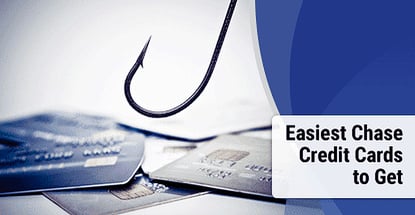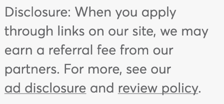Headlined by its sleek metal-alloy Chase Sapphire Preferred® Card and Chase Sapphire Reserve® travel cards, Chase’s house offering of credit cards holds some of the most sought-after rewards cards on the market. But as with most things coveted by the masses, Chase credit cards can’t be had by just any applicant.
In fact, the majority of Chase’s popular lineup of consumer and business credit cards are catered to the upper echelon of credit scores, excellent-credit consumers with FICO scores above 740. That being said, the issuer does have two choice rewards card options that are easier to get for those with good credit. Keep reading as we take a closer look at these cards, and you can decide which one might be the easiest Chase card to get for your personal situation. We’ll offer up some quality alternative cards for consideration as well.
Good-Credit Cards | Other Top Options | Business Cards | The 5/24 Rule
Chase Freedom Flex℠ and Chase Freedom Unlimited® Accept Good Credit
When it comes to cards you’ll want to use every day, the Chase Freedom Flex℠ card and its sibling, the Chase Freedom Unlimited®, have a lot going for them. Not only do the cards charge no annual fee, but they also earn solid rewards, come with attainable signup bonuses, and offer introductory 0% APR offers — all in the same good-credit-friendly packages.
The simpler of the two cards, the Chase Freedom Unlimited®, offers a tiered cash back rewards system on travel, dining, and drugstore purchases plus a single flat-rate cash back reward on all other purchases, regardless of the category. Since the flat-rate rewards of the Chase Freedom Unlimited® are, well, unlimited, the card can be a good choice for those who don’t make a lot of purchases in common bonus categories or who are looking for a higher flat rate on non-category purchases.
In contrast, the Chase Freedom Flex℠ offers the same tiered cash back rates, but cardholders earn 1% unlimited cash back on all other purchases. What mainly differentiates this card is that it operates on a rotating category bonus system. Each quarter you can activate a special bonus category — things like gas, groceries, and restaurants — then you’ll earn bonus cash back on purchases in that category for the rest of the quarter, on up to a purchase limit.
This card is currently not available. Additional Disclosure: The information related to Chase Freedom Flex℠ credit card has been collected by CardRates.com and has not been reviewed or provided by the issuer of this card.2. Chase Freedom Flex℠
Category purchases made with the Chase Freedom Flex℠ over the quarterly purchase limit and all non-category or tiered purchases will earn an unlimited 1% cash back rewards. Additionally, while each quarter offers a main bonus category, several more niche categories may also be included. For example, Q1 of 2018 offers bonus rewards for gas station purchases, but also provides bonus rewards for certain utilities and digital payment services.
Since the qualification requirements for both the Chase Freedom Flex℠ and Chase Freedom Unlimited® are basically the same, your chances of qualifying for either version will also likely be the same. In general, Chase promotes the cards to consumers with good to excellent credit, so while there may be reports from users who have been approved with lower credit scores, your experience may vary.
Most Chase Cards Require Excellent Credit to Qualify
For the majority of the Chase stable of cards, excellent credit will generally be the key to approval. This doesn’t simply mean a good credit score, either; you’ll likely need at least a year (preferably two or three) of positive payment history, with no major blemishes in sight. This will be especially true if you want to qualify for one of the cards that come exclusively as Visa Signature® or Visa Infinite® products.
For example, the metal-alloy Chase Sapphire Reserve® card is one of the more high-end cards offered by Chase, and one often at the top of the list for frequent travelers despite its high annual fee. The card offers triple Ultimate Rewards® points per dollar for travel and dining, as well as a slew of other exclusive travel benefits and bonuses, including an annual travel credit reimbursement and Priority Pass™ membership.
All in the all, the Chase Sapphire Reserve® is likely the most difficult to obtain of the Chase credit cards, partly due to the fact that it is a Visa Infinite® product, which tends to have higher credit limits. As stated in its pricing and terms information, the minimum credit line for approved applicants is $10,000, so you’ll need to qualify for at least that amount to be approved.
If the fee for the Chase Sapphire Reserve® is a little rich for your tastes, you may like the card’s little sibling, the Chase Sapphire Preferred® Card. For a fraction of the annual fee, you can earn double Ultimate Rewards® points per dollar on travel and dining, pay no foreign transaction fees, and still enjoy the fancy metal-alloy composition that gives the card its solid weight and ritzy feel.
While not quite as exclusive as its sibling, the Chase Sapphire Preferred® Card is only the next tier down as a Visa Signature® card. Since the minimum credit line for new card applicants is $5,000 (per the pricing and terms), you’ll need to be able to qualify for at least that amount to be approved for the Chase Sapphire Preferred® Card.
Although not a rewards card, the Chase Slate® is at the top of many a list of good balance transfer cards, both because of its extensive introductory 0% APR offer, but also because it’s one of the few cards from major banks with no balance transfer fee. Furthermore, the Chase Slate® intro-APR offer also extends to new purchases, giving you a double-whammy interest rate deal.
Unlike the others on the list, the basic Chase Slate® is just a regular Visa card, though a Visa Signature® version is available to those who qualify. Make sure you read the fine print, however, including noting that only balance transfers made within the first 60 days of account opening will be fee-free. Additionally, you won’t be able to transfer a balance from another Chase credit card or loan account to the Chase Slate.
Chase Business Cards Also Require Excellent Credit
Like most of the family, Chase’s duo of business credit cards are also targeted to the upper end of the credit score spectrum. This means if your business has yet to establish its own excellent credit, your personal credit should be fairly spotless to qualify for a Chase business card.
The main differences between the two are the type of rewards, bonus categories, and spending caps. The Ink Business Cash® Credit Card, for instance, offers cash back rewards, with several tiers of bonus rewards, the highest offering 5% cash back on office supply purchases and certain utility services. You can only earn bonus rewards on up to $25,000 in purchases for each bonus tier level per account anniversary year.
If you prefer to earn rewards points, the Ink Business Preferred® Credit Card card may be a better choice. While its single bonus rewards tier only provides 3X points per $1, it applies to travel, shipping, advertising purchases, and some utility services. It also has a higher spending cap, allowing cardholders to earn bonus rewards on up to $150,000 of combined category purchases each anniversary year.
The fringe benefits of each card may also play a role in deciding between the two. For example, the Ink Business Cash® Credit Card comes with an introductory 0% APR deal on new purchases and balance transfers that may prove handy for some cardholders, and it charges no annual fee. The Ink Business Preferred® Credit Card does charge an annual fee but comes with a more valuable signup bonus, extra travel benefits, and cellphone protection.
The 5/24 Rule Can Mean a Rejection Regardless of Credit
Unfortunately, no matter how good your credit may be, you can still be turned down for a Chase credit card due to a little policy colloquially called the 5/24 Rule. In essence, the rule means that your Chase credit card application will likely be automatically rejected if you have opened five or more bank cards (credit or charge cards) within the last 24 months.
While the policy has only sporadically been captured as a written statement, “too many recent accounts” is a frequent reason given to rejected applicants during reconsideration calls and in letters. At first, the policy applied to only a handful of cards but has since been expanded to include nearly every Chase-branded (and co-branded) credit card.
Overall, research done by concerned churners has revealed a shortlist of cards issued by Chase that may not fall under the 5/24 Rule (no guarantees, folks). All of the cards are co-branded cards, and most will have annual fees:
- AARP® Credit Card from Chase
- Amazon Rewards Visa Signature® Card
- Disney® Premier Visa® Card
- Disney® Visa® Card
Outside of being picky about your cards, anecdotal evidence also indicates you may have a couple of other options for getting around the rule, however, the most effective methods seem to be for existing Chase customers. Specifically, the successful reports are generally about consumers who received an unsolicited offer through their online Chase account or from a teller in a Chase bank branch. However, most of these reports are old; more recent evidence suggests they may no longer be effective.
Build Your Credit to Open More Chase Possibilities
With some of the top-rated cash back and rewards points credit cards on the market and millions of existing cardholders, Chase can afford to be picky about approvals for its cards. Unfortunately, this means that, unlike most big credit card issuers, Chase doesn’t offer any fair-credit starter cards to get your foot in the door.
No, to get your hands on a Chase credit card, you’ll generally need to do it the old-fashioned way: build a positive credit history. With 12 months or more of on-time payments with another credit card or two — and a healthy dose of restraint in opening new accounts — your credit can be well on its way to being Chase-approved.
Advertiser Disclosure
CardRates.com is a free online resource that offers valuable content and comparison services to users. To keep this resource 100% free, we receive compensation for referrals for many of the offers listed on the site. Along with key review factors, this compensation may impact how and where products appear across CardRates.com (including, for example, the order in which they appear). CardRates.com does not include the entire universe of available offers. Editorial opinions expressed on the site are strictly our own and are not provided, endorsed, or approved by advertisers.


![15 Easiest Credit Cards to Get ([updated_month_year]) 15 Easiest Credit Cards to Get ([updated_month_year])](https://www.cardrates.com/images/uploads/2018/12/easytoget.png?width=158&height=120&fit=crop)
![6 Easiest Credit Cards to Get Approved For ([updated_month_year]) 6 Easiest Credit Cards to Get Approved For ([updated_month_year])](https://www.cardrates.com/images/uploads/2020/02/Easiest-Credit-Cards-to-Get-Approved-For.jpg?width=158&height=120&fit=crop)
![8 Easiest Approval Cards For Fair & Bad Credit ([updated_month_year]) 8 Easiest Approval Cards For Fair & Bad Credit ([updated_month_year])](https://www.cardrates.com/images/uploads/2021/07/Easiest-Approval-Cards-For-Fair-Bad-Credit.jpg?width=158&height=120&fit=crop)
![#1 Easiest Capital One Card to Get ([updated_month_year]) #1 Easiest Capital One Card to Get ([updated_month_year])](https://www.cardrates.com/images/uploads/2021/08/Easiest-Capital-One-Card-to-Get.jpg?width=158&height=120&fit=crop)
![7 Easiest Balance Transfer Cards to Get ([updated_month_year]) 7 Easiest Balance Transfer Cards to Get ([updated_month_year])](https://www.cardrates.com/images/uploads/2023/07/Easiest-Balance-Transfer-Cards-to-Get.jpg?width=158&height=120&fit=crop)
![11 Easiest Online Loans ([updated_month_year]) 11 Easiest Online Loans ([updated_month_year])](https://www.cardrates.com/images/uploads/2020/07/shutterstock_443859163.jpg?width=158&height=120&fit=crop)
![11 Easiest Loans To Get Approved For ([updated_month_year]) 11 Easiest Loans To Get Approved For ([updated_month_year])](https://www.cardrates.com/images/uploads/2021/07/Easiest-Loans-To-Get-Approved-For.jpg?width=158&height=120&fit=crop)
![How the Chase 5/24 Rule Works & Which Credit Cards It Affects ([updated_month_year]) How the Chase 5/24 Rule Works & Which Credit Cards It Affects ([updated_month_year])](https://www.cardrates.com/images/uploads/2018/03/5242.png?width=158&height=120&fit=crop)